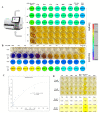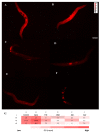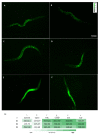Antibacterial, Antibiofilm, and Antioxidant Activity of 15 Different Plant-Based Natural Compounds in Comparison with Ciprofloxacin and Gentamicin
- PMID: 36009966
- PMCID: PMC9404727
- DOI: 10.3390/antibiotics11081099
Antibacterial, Antibiofilm, and Antioxidant Activity of 15 Different Plant-Based Natural Compounds in Comparison with Ciprofloxacin and Gentamicin
Abstract
Plant-based natural compounds (PBCs) are comparatively explored in this study to identify the most effective and safe antibacterial agent/s against six World Health Organization concern pathogens. Based on a contained systematic review, 11 of the most potent PBCs as antibacterial agents are included in this study. The antibacterial and antibiofilm efficacy of the included PBCs are compared with each other as well as common antibiotics (ciprofloxacin and gentamicin). The whole plants of two different strains of Cannabis sativa are extracted to compare the results with sourced ultrapure components. Out of 15 PBCs, tetrahydrocannabinol, cannabidiol, cinnamaldehyde, and carvacrol show promising antibacterial and antibiofilm efficacy. The most common antibacterial mechanisms are explored, and all of our selected PBCs utilize the same pathway for their antibacterial effects. They mostly target the bacterial cell membrane in the initial step rather than the other mechanisms. Reactive oxygen species production and targeting [Fe-S] centres in the respiratory enzymes are not found to be significant, which could be part of the explanation as to why they are not toxic to eukaryotic cells. Toxicity and antioxidant tests show that they are not only nontoxic but also have antioxidant properties in Caenorhabditis elegans as an animal model.
Keywords: Caenorhabditis elegans; antibacterial agents; antibiotics; antioxidant; biofilms; cannabinoids; essential oils; herbal; mechanism; natural compounds; plant-based compounds; toxicity.
Conflict of interest statement
The authors declare no competing financial interests.
Figures








Similar articles
-
Chemical Composition, Antioxidant, Antibacterial, and Antibiofilm Activities of Backhousia citriodora Essential Oil.Molecules. 2022 Jul 31;27(15):4895. doi: 10.3390/molecules27154895. Molecules. 2022. PMID: 35956846 Free PMC article.
-
Novel pentafluorosulfanyl-containing triclocarban analogs selectively kill Gram-positive bacteria.Microbiol Spectr. 2024 Jun 4;12(6):e0007124. doi: 10.1128/spectrum.00071-24. Epub 2024 May 3. Microbiol Spectr. 2024. PMID: 38700321 Free PMC article.
-
Evaluation of antibiofilm efficacy of essential oil components β-caryophyllene, cinnamaldehyde and eugenol alone and in combination against biofilm formation and preformed biofilms of Listeria monocytogenes and Salmonella typhimurium.Lett Appl Microbiol. 2020 Aug;71(2):195-202. doi: 10.1111/lam.13308. Epub 2020 May 29. Lett Appl Microbiol. 2020. PMID: 32357268
-
Evolving biofilm inhibition and eradication in clinical settings through plant-based antibiofilm agents.Phytomedicine. 2023 Oct;119:154973. doi: 10.1016/j.phymed.2023.154973. Epub 2023 Jul 17. Phytomedicine. 2023. PMID: 37499434 Review.
-
Hybrid combinations containing natural products and antimicrobial drugs that interfere with bacterial and fungal biofilms.Phytomedicine. 2017 Dec 15;37:14-26. doi: 10.1016/j.phymed.2017.10.021. Epub 2017 Nov 23. Phytomedicine. 2017. PMID: 29174600 Review.
Cited by
-
Essential Oils of Aromatic Plant Species from the Atlantic Rainforest Exhibit Extensive Chemical Diversity and Antimicrobial Activity.Antibiotics (Basel). 2022 Dec 19;11(12):1844. doi: 10.3390/antibiotics11121844. Antibiotics (Basel). 2022. PMID: 36551501 Free PMC article.
-
Tea Tree Oil: Properties and the Therapeutic Approach to Acne-A Review.Antioxidants (Basel). 2023 Jun 12;12(6):1264. doi: 10.3390/antiox12061264. Antioxidants (Basel). 2023. PMID: 37371994 Free PMC article. Review.
-
Probing the Physicochemical, Nanomorphological, and Antimicrobial Attributes of Sustainable Silk Fibroin/Copaiba Oleoresin-Loaded PVA Films for Food Packaging Applications.Polymers (Basel). 2025 Jan 30;17(3):375. doi: 10.3390/polym17030375. Polymers (Basel). 2025. PMID: 39940576 Free PMC article.
-
Thymol and carvacrol against Klebsiella: anti-bacterial, anti-biofilm, and synergistic activities-a systematic review.Front Pharmacol. 2024 Oct 24;15:1487083. doi: 10.3389/fphar.2024.1487083. eCollection 2024. Front Pharmacol. 2024. PMID: 39512827 Free PMC article.
-
In Vitro and In Vivo Antibacterial and Antibiofilm Activity of Zinc Sulfate (ZnSO4) and Carvacrol (CV) Alone and in Combination with Antibiotics Against Pseudomonas aeruginosa.Antibiotics (Basel). 2025 Apr 1;14(4):367. doi: 10.3390/antibiotics14040367. Antibiotics (Basel). 2025. PMID: 40298523 Free PMC article.
References
-
- WHO Publishes List of Bacteria for Which New Antibiotics Are Urgently Needed. [(accessed on 27 February 2017)]. Available online: https://www.who.int/news/item/27-02-2017-who-publishes-list-of-bacteria-....
Grants and funding
LinkOut - more resources
Full Text Sources
Miscellaneous

